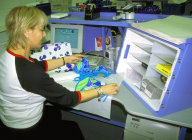Apr 01, 2003April 2, 2003 - Coping with 104 different brands and more than 18,000 different stock keeping units is a real challenge. Radio frequency identification has helped Figleaves, a UK-based Web site that sells intimate apparel, do it successfully. And the company plans to expand its use of the technology in stages.
Figleaves, which was founded in 1998, sources much of its product from Paris. It has a warehouse in North London and is building another in the US. The warehouse has perpetual inventory. Bras, panties, lingerie and other items are stored in "figbins", which are identified with bar codes and placed anywhere in the warehouse.
Prior to adopting the RFID system, staff would locate the right bin in the warehouse and pick one order at a time. Now, they use a pick-to-light cart from Microlise. Each cart carries three totes, each with eight compartments, so they can pick 24 orders in one trip through the warehouse.
The carts are equipped with radio data terminals that tell the warehouse staff to go to find the right bin. Staff then scan a bar code on the bin and the bar code on the shelf to make sure it matches. If it does, they scan the bar code on the item, and the system on the cart lights up the right tote compartment for that item.
When all the orders have been picked, the totes are put on a conveyor and sent down to the packaging area, where staff put the orders into boxes for shipping. Since there are three tote locations in the packaging area, Figleaves tagged 100 totes with RFID transponders from Texas Instruments and put readers in the bays, so that the system can correctly identify which tote is in which location. That prevents staff from mixing up the orders about to be sent out and saves the time and labor spent on double-checking orders before they are shipped.
Daniel Nabarro, chairman and founder of Figleaves, says the system enables staff to pick 60,000 items a month with an error rate of less than 0.1 percent. But he would like to eliminate all failed picks by using RFID to make sure bins are where they are supposed to be. Today, if a bin is not in the right location, it's very hard to find because it could be almost anywhere in the facility.
Nabarro says he would like to install RFID tags on the shelf edges and on the bins. That way, staff could stroll through the warehouse, scan the shelves with a handheld scanner and make sure every bin is in the right location. That would mean that when staff pulled up with a cart, they would be virtually guaranteed to find the right product right away.
"Next year, we won't use RFID on the totes," he says. "We will pick directly into the box. The system has done the job, but we can now do things better. If we know the bin is in the right location, we can virtually eliminate errors."
Nabarro says the ultimate goal would be to tag every item in a bin, but it will depend on the price of RFID tags falling. "We can make it pay at 10 cents per RFID tag," he says. "The benefits are marginal if the cost of the tag is any higher than that."
RFID tags on each item would make it possible to virtually guarantee that the correct order is shipped to the customer every time. It would also enable the company to more effectively track returns. "We would love to be able to do it," he says of item-level tagging. "The obvious advantage for me is to walk up to a bin, scan it and know exactly what's inside. These are small items that are very messy to have to count."


